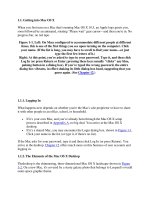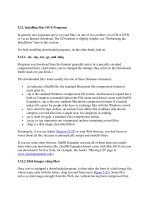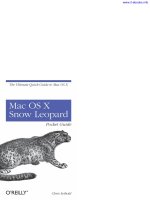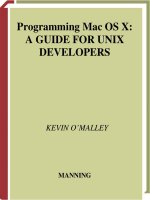Mac OS X Technology Guide to Automator Preview phần 1 pot
Bạn đang xem bản rút gọn của tài liệu. Xem và tải ngay bản đầy đủ của tài liệu tại đây (2.61 MB, 10 trang )
Automate Your Mac
Mac OS X
Technology
Guide to
Automator
Preview
Full Version Available at
www.automatedworkflows.com
By Ben Waldie
Mac OS X Technology Guide to
Automator
BEN WALDIE
Table of Contents
3
How to Use this eBook
About the Author
Acknowledgements
Chapter : Introduction
Goals of this Book 10
What You Need to Get Started 11
Example Code 12
Section : Using Automator
Chapter : Automator Overview
Benets of Automator 14
How Does Automator Work? 15
Chapter : Automator's Interface
Navigating Automator’s Interface 20
Chapter : Constructing a Workow
Creating a New Workow 30
Adding Actions to a Workow 31
Conguring Action Settings 32
Working with Input and Output Values 35
Collapsing Actions in a Workow 39
Deleting Actions from a Workow 39
Disabling Actions in a Workow 41
Moving an Action in a Workow 42
Chapter : Utilizing a Workow
Saving Workows 43
Opening a Workow 55
Printing a Workow 56
Running a Workow 57
Troubleshooting 59
Importing Actions 62
Importing a Workow 63
Creating a Workow from Finder Items 64
Chapter : Building an
Example Workow
Workow Example 1 –
Backup Safari Data 66
Workow Example 2 –
Email Photo Contact Sheet 73
Chapter : Advanced Topics
Working with Spotlight 81
Triggering UNIX commands 83
Working with AppleScript 83
Developer-Related Actions 85
Providing Feedback 85
Section : Developing for Automator
Chapter 8: Introduction to
Developing for Automator 88
Related Technologies Overview 88
Types of Automator Actions 97
What You Need to Get Started 97
Table of Contents
4
Chapter : How Actions Work
What is an Action? 98
Threading 102
Where Actions are Stored 103
Chapter : Planning an Action
Action Functionality 106
Action Input and Output 107
Action Settings 107
Action Naming 108
Chapter : Building an Action Project
Creating the Project 109
Action Template Components 111
Chapter : Conguring an
Action's Property List File
Editing Properties 114
Conguring General Action Properties 119
Conguring an Action’s Icon 121
Conguring an Action’s Description 124
Conguring Action Input
and Output Values 128
Adjusting Action Behavior 132
Specifying Required Resources 133
Conguring a Warning 135
Localized Property List Strings 137
Example info.plist File 139
Chapter : Constructing
an Action's Interface
Preparing for Automator Action
Interface Development 141
Building an Action’s Interface 143
Interface Design Guidelines 145
Grouping Interface Elements 148
Chapter : Retrieving
an Action's Settings
Establishing Interface
Element Bindings 151
Linking Parameters to the
Action’s Code 156
Chapter : Adding Code to an Action
Action Processing Code Overview 158
Adding Code to an AppleScript Action 159
Adding Code to a Cocoa
(Objective-C) Action 165
Triggering Code From Other
Languages 171
Conversion Actions 172
Table of Contents
5
Chapter : Testing and
Debugging an Action
Building and Running from
within Xcode 174
Building, Installing, and Testing 176
Building and Debugging 177
Tips for Testing Actions 178
Common Problems and
Possible Solutions 179
Chapter : Pulling it Together
Log Activity AppleScript-Based Action 181
Adjust Image Color Cocoa
Objective-C-Based Action 190
Chapter : In Conclusion
General Automator Resources 201
Developer Resources 203
In Closing 206
Appendix A: Automator Action
Development Step-By-Step
Appendix B: Automator Input and
Output Uniform Type Identiers (UTIs)
License Agreement
Index
How to Use this eBook
6
On-Screen Viewing
We recommend using Adobe Acrobat or the free Adobe Reader to view this ebook. Apple Preview and other
third-party PDF viewers may also work, but many of them do not support the latest PDF features. For best
results, use Adobe Acrobat/Reader.
To jump directly to a specific page, click on a topic from either the Table of Contents on the first page or from
the PDF Bookmarks. In Adobe Reader, the PDF Bookmarks can be accessed by clicking on the Bookmarks tab
on the left side of the screen. In Apple Preview, the PDF Bookmarks are located in a drawer (Command-T to
open).
If your mouse cursor turns into a hand icon when hovering over some text, that indicates the text is a
hyperlink. Table of Contents links jump to a specific page within the ebook when clicked. Text links that
begin with “http” or “ftp” will attempt to access an external web site or FTP server when clicked (requires an
Internet connection).
Printing
Since this ebook utilizes a unique horizontal page layout for optimal on-screen viewing, you should choose
the “Landscape” setting (in Page Setup) to print pages sideways on standard 8.5” x 11” paper. If the Orientation
option does not label the choices as “Portrait” and “Landscape”, then choose the visual icon of the letter "A" or
person’s head printed sideways on the page (see example below).
About the Author
7
The Author
Ben Waldie is president of Automated Workflows, LLC, a company offering AppleScript,
Automator, and workflow consulting services to Mac-based businesses. For years, Ben has
developed professional automated solutions for companies such as Abercrombie & Fitch,
Adobe Systems, Apple Inc., CNN, Microsoft, NASA, PC World, and Time Magazine. Ben
is the author of Automator for Mac OS X 10.5 Leopard Visual QuickStart Guide (Peachpit
Press), AppleScripting the Finder, and has written AppleScript and Automator content for
Apple.com, Macworld, MacTech, MacScripter.net, and X-Ray Magazine, and is the host of
the Mac Automation Made Simple video podcast (Peachpit Press). Ben is also the author
of an AppleScript training CD for the Virtual Training Company, is a frequent presenter at
Macworld Expo and other events, and is president of e Philadelphia Area AppleScript
Users Group.
Visit Automated Workflows, LLC online: omatedworkows.com/
The Book
Optimized for easy on-screen reading, yet perfect for printing, this eBook has been
uniquely formatted and hyperlinked for fast access and quick learning.
8
I would like to take this opportunity to sincerely thank a
number of people who have directly led to, and assisted
with, the creation of this book. First off, I would
like to thank my wife, Jenifer, who spent many a late
night reading, proofing, and offering input. Without
her, many of the things that I set out to accomplish
would not be possible. I would also like to thank Tim
Davis, who gave me the opportunity to learn about
AppleScript and development on the Mac so very many
years ago and was kind enough to let me run with it.
anks to Sal Soghoian, who offered very helpful input,
suggestions, and information about Automator, and
who, along with the incredibly talented AppleScript
team at Apple, continues to keep AppleScript alive, well,
and growing.
anks to Mark Dalrymple, and his extensive
knowledge of Objective-C, for providing valuable input
regarding the Objective-C-related sections of this book.
Finally, I would like to thank Dave Mark and Dave
Wooldridge for giving me the opportunity to write this
book, and for the incredible things they do to make this
book and so many other great books possible.
– Ben Waldie
Acknowledgements
A
Chapter 1 Introduction
9
utomation has always been an important part of
personal computing. Since it was first created, the
overall purpose of the computer has been to make life
easier by performing complex and repetitive tasks in an
efficient and reliable manner.
However, does your computer really make your life
easier? Or, does it seem to make more work for you
to do? For many, the latter seems to be the case, but
it doesn’t need to be. Your computer’s ability to make
your life easier is directly related to how you are actually
using your computer.
Everything you do on your computer involves software.
Software controls the physical hardware of your
computer, while providing you with the tools you need
to accomplish specific tasks, such as page layout, image
editing, and word processing.
If you’re like me, then your workflow probably involves
numerous software applications, and you probably find
yourself doing many of the same things over and over
again. Take a look at digital photography, for example.
If you have a digital camera, each time you plug it into
your computer, you need to download the images into
a folder structure, import them into a photo catalog,
rename the images, etc. Applications like iPhoto can
help tremendously with these tasks by automating
the process for you. If you look closely at your own
workflow, you will probably see a number of tasks that
are being automated by your software.
Some of the time, your software will do everything
that you need it to do, and in an efficient manner.
However, this isn’t always the case. In some cases,
your needs may be quite unique, and you may require
customized features or tools that don’t yet exist within
your software. In other cases, your software may work
perfectly, but it doesn’t provide a way to automate those
time-consuming tasks that you perform on a regular
basis, or it may not provide a way to move your data
efficiently between multiple applications.
If you are a programmer, then you may be able to write
your own custom software, or you may be able to
automate your existing software using something like
AppleScript. But, what if you’re not a programmer?
With the release of Mac OS X 10.4, your prayers
have been answered. Installed with the Mac OS is
10
Chapter 1:
Introduction
Automator, a tool for the average user with one specific
function – to automate time consuming and repetitive
tasks for your specific workflow.
Introduction to Automator
As we will discuss throughout this book, Automator
will allow you to define how repetitive and time-
consuming tasks are automated on your Mac, with
no programming required. With a user-friendly
interface, Automator will allow any user to construct a
customized automated workflow, simply by dragging
and dropping icons around, and by specifying a few
options.
Within the Automator application, users work with
two main types of components, actions and workows.
Actions are built by developers, and each action’s goal is
to perform a single task, such as opening a file, checking
your email, or rotating an image. Workflows are
designed and constructed by users, by piecing together
actions in order to create a virtual assembly line of
automated tasks. Once constructed, workflows may be
saved and triggered by a user in a variety of ways.
Programmers are in luck too. Mac OS X includes all
of the tools needed to build your own custom actions,
which can be plugged right into the Automator
application, extending the possibilities of user-defined
automation even further.
Goals of this Book
roughout this book, we will take an in-depth look
at Automator from the perspective of both a user and
a developer. e book will be broken into two main
sections.
In the first section, geared toward users, we will explore
the Automator application itself. We will discuss the
features and benefits of Automator, and we will walk
through using it in order to construct and execute
automated workflows that meet your specific needs.
e second section of the book will focus on how you
can develop your own Automator actions. We will
explore the tools used to build Automator actions,
take a look at example code, and discuss resources for
continued learning.
By the end of the users section of this book, you
should have a good understanding of the Automator
application, and you should feel comfortable using
it. If you are a developer, then the developer section
of this book should provide you with the confidence
and knowledge that you will need to begin building
your own actions, whether for personal use, or for
commercial or freeware distribution.









